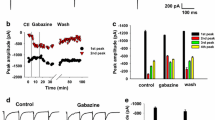Abstract
Intraspinal microstimulation was used to test the excitability of single cutaneous (sural) A- and C-fibers at their central terminals in the cat. Systemic morphine (1.0–2.6 mg/kg) increased the antidromic threshold to 110% (mean value) of control in C-fibers. In some of the C-fibers this effect was reversed by naloxone. A-fibers were not consistently affected by mophine.
Similar content being viewed by others
References
Atweh, S. F., Kuhar, M. J.: Autoradiographic localization of opiate receptors in rat brain. I. Spinal cord and medulla. Brain Res.124, 53–67 (1977)
Burgess, P. R., Perl, E. R.: Cutaneous mechanoreceptors and nociceptors. In: Handbook of sensory physiology, Vol. II, somatosensory system. Iggo, A. (ed.), pp. 30–78. Berlin, Heidelberg, New York: Springer 1973
Calvillo, O.: Presynaptic effects of opiates and their antagonists in the spinal cord of the cat. Proc. Can. Fed. Biol. Soc.19, 171 (1976)
Chin, J. H., Crankshaw, D. P., Kendig, J. J.: Changes in the dorsal root potential with diazepam and with the analgesics aspirin, nitrous oxide, morphine, and meperedine. Neuropharmacology.13, 305–315 (1974)
Duggan, A. W., Hall, J. G., Headley, P. M.: Suppression of transmission of nociceptive impulses by morphine administered in the region of the substantia gelatinosa. Br. J. Pharmacol.61, 65–76 (1977)
Herz, A. (ed.): Developments in opiate research. New York: Marcel Dekker 1978
Herz, A., Teschemacher, H.-J.: Activities and sites of antinociceptive action of morphine-like-analgesics and kinetics of distribution following intravenous, intracerebral and intraventricular application. In: Advances in drug research, Vol. 6, Harper, N. J., Simmonds, A. B. (eds.), pp. 79–119. New York: Academic Press 1971
Hiller, J. M., Simon, E., Crain, S. M., Peterson, E. R.: Opiate receptors in cultures of fetal mouse dorsal root ganglia (DRG) and spinal cord: predominance in DRG neurites. Brain Res.145, 396–400 (1978)
Jänig, W., Zimmermann, M.: Presynaptic depolarization of myelinated afferent fibres evoked by stimulation of cutaneous C-fibers. J. Physiol. (Lond.)214, 29–50 (1971)
Jänig, W., Zimmermann, M.: Excitability testing and slow potential changes at the intraspinal terminals of cutaneous afferent C-fibers. (Manuscript in preparation)
Jessel, T. M., Iversen, L. L.: Opiate analgesics inhibit substance P release from rat trigeminal nucleus. Nature268, 549–551 (1977)
Jurna, I., Grossmann, W.: The effect of morphine on mammalian nerve fibres. Eur. J. Pharmacol.44, 339–348 (1977)
La Motte, C., Pert, C. B., Snyder, S. H.: Opiate receptor binding in primate spinal cord: distribution and changes after dorsal root section. Brain Res.112, 407–412 (1976)
LeBars, D., Menetrey, D., Besson, J. M.: Effects of morphine upon the lamina V type cells activities in the dorsal horn of the decerebrate cat. Brain Res.113, 293–310 (1976)
MacDonald, L. R., Nelson, P. G.: Specific-opiate-induced depression of transmitter release from dorsal root ganglion cells in culture. Science199, 1449–1451 (1978)
Morris, M. E., Calvillo, O., Fox, S.: Effects of morphine, fentanyl and naloxone on central synaptic transmission. Pain Abstracts Vol. 1, 2nd World Congr. Pain, p. 79. Montreal (1978)
Pert, C. B., Kuhar, M. J., Snyder, S. H.: Opiate-receptor-autradiographic localization in rat brain. Proc. Natl. Acad. Sci. U.S.A.73, 3729–3733 (1976)
Sastry, B. R.: Morphine and met-enkephalin effects on sural Aδ afferent terminal excitability. Eur. J. Pharmacol.50, 269–273 (1978)
Schmidt, R. F.: Presynaptic inhibition in the vertebrate central nervous system. Rev. Physiol. Biochem. Pharmacol.63, 21–101 (1971)
Schmidt, R. F., Senges, J., Zimmermann, M.: Excitability measurements at the central terminals of single mechanoreceptor afferents during slow potential changes. Exp. Brain Res.3, 220–233 (1967)
Wall, P. D.: Excitability changes in afferent fibre terminations and their relation to slow potentials. J. Physiol (Lond.)142, 1–12 (1958)
Yaksh, T. L., Rudy, T. A.: Narcotic analgetics: CNS sites and mechanisms of action as revealed by intracerebral injection techniques. Pain4, 299–359 (1978)
Zieglgänsberger, W., Fry, J. P.: Actions of opioids on single neurons. In: Developments in opiate research, Herz, A. (ed.), pp. 193–239. New York: Marcel Dekker, 1978
Author information
Authors and Affiliations
Additional information
Preliminary reports were given at the NIMH-conference on “Endorphins in mental health research”, held in San Juan, Puerto Rico (1977), and at the joint meeting of the British and German Physiological Societies, Cambridge/England (July 1978)
Rights and permissions
About this article
Cite this article
Carstens, E., Tulloch, I., Zieglgänsberger, W. et al. Presynaptic excitability changes induced by morphine in single cutaneous afferent C- and A-fibers. Pflugers Arch. 379, 143–147 (1979). https://doi.org/10.1007/BF00586940
Received:
Issue Date:
DOI: https://doi.org/10.1007/BF00586940



